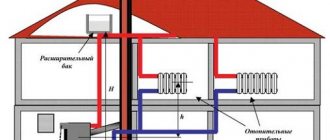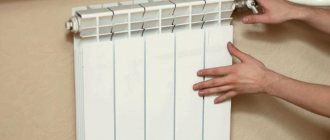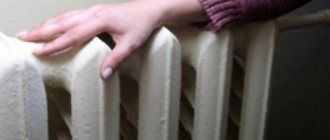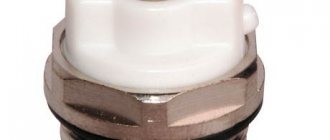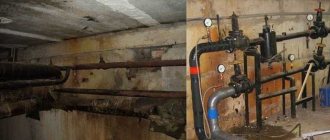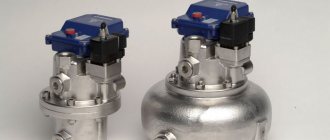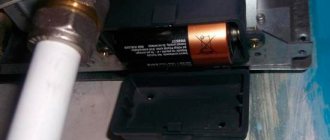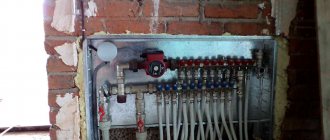Cold batteries in winter are an emergency that requires an immediate solution. To fix serious problems, you should hire specialists, but some problems can be dealt with on your own. Even if the owner of an apartment or house does not intend to repair the heating on his own, it will not hurt him to know about the signs and causes of malfunctions.
Signs and causes of poor heating performance
| Characteristic signs | Possible reasons |
| The riser is cold | Technical faults outside the apartment |
| The riser is hot, the batteries are cold | Valves are closed, heating system is clogged |
| Cold bottom of radiator | Valves are not open enough, radiators are clogged, low coolant pressure in pipes |
| Cold top of batteries | Airlock |
| The last radiator in the system is cold | System not adjusted, insufficient pressure |
| The part of the radiator farthest from the connection pipes is cold | Insufficient pressure, clogged battery, air lock |
An analysis of the events preceding their occurrence will help identify the causes of malfunctions.
| Work carried out, operating features | Possible faults |
| Replacement of heating devices, pipes | Air lock due to air entering the system or changes in pipe slopes. Clogged pipes and radiators. Reduced flow areas due to errors during system assembly |
| The heating system works without maintenance for many years | Scale has formed, the heat transfer of the batteries has deteriorated, and parts of the shut-off valves have become “stuck” |
| Start of the heating season | The boiler room did not reach its design capacity, employees of the relevant services forgot to open the valves, and air pockets formed when the system was filling. |
| Neighbors were doing renovations | Reduced pressure in the system due to unprofessional actions of neighbors |
First of all, if the heating is poor, interview the residents of the house. If they have the same problem, it means that the boiler room is not working well or the valves in the basement of the house are closed. In these cases, you should jointly contact the management company. If only one apartment is cold, check that the valves are open and there are no air pockets. Call a specialist through the dispatcher of the organization serving the house.
Consequences of cold return
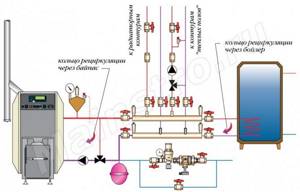
Circuit for heating return
Sometimes, with an incorrectly designed design, the return flow in the heating system is cold. As practice shows, the fact that the room does not receive enough heat with a cold return is half the trouble. The fact is that at different supply and return temperatures, condensation may form on the walls of the boiler, which, when interacting with carbon dioxide released during fuel combustion, forms acid. It can also damage the boiler much ahead of time.
To avoid this, it is necessary to carefully consider the design of the heating system, special attention must be paid to such a nuance as the return temperature. Or include additional devices in the system, for example, a circulation pump or boiler, which will compensate for the loss of warm water
Radiator connection options
Now we can more than confidently say that when designing a heating system, the supply and return must be perfectly thought out and configured. If the design is incorrect, more than 50% of the heat can be lost
.
There are three options for inserting a radiator into the heating system:
- Diagonal.
- Lateral.
- Bottom.
The diagonal system gives the highest efficiency coefficient, and is therefore more practical and efficient.
The diagram shows a diagonal inset
How to regulate the temperature in the heating system?
In order to regulate the temperature of the radiator and reduce the difference between the supply and return temperatures, you can use a heating system temperature controller.
When installing this device, do not forget about the jumper, which must be located in front of the heating device. If it is absent, you will regulate the temperature of the batteries not only in your room, but throughout the riser. It is unlikely that the neighbors will be happy with such actions.
The simplest and cheapest option for a regulator is to install three valves: on the supply, on the return and on the jumper. If you cover the valves on the radiator, the jumper must be open.
There is a huge abundance of different thermostats that can be used in apartment and private buildings. Among the wide variety, each consumer can choose a regulator that will suit him in terms of physical parameters and, of course, cost.
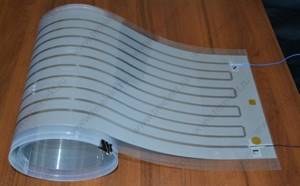
Infrared film heating - pros and cons
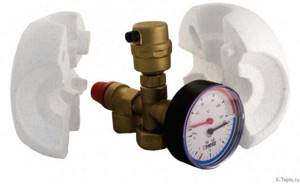
Safety valve in the heating system
Basic malfunctions of heating systems and their elimination
Air jams
Air pockets occur in radiators and pipes and interfere with the normal circulation of water in the heating system. They appear for various reasons:
- violation of the technology for filling the system with water after the summer period;
- non-compliance with water deaeration regime;
- performing repairs with disassembling pipelines;
- failure to observe slopes when installing the heating system;
- air leakage through leaky joints.
To remove air from the system, use a Mayevsky valve installed on the radiator. You should open it, wait until the air comes out, the hissing stops, and the water begins to pour out calmly without bubbles. After this, the valve is closed. Don't forget to provide a container or towel to drain the water.
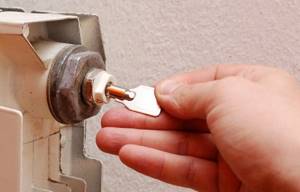
Old cast iron batteries do not have Mayevsky taps. The air is released without completely unscrewing the plugs at the ends of the radiators. It is better to entrust this operation to plumbers - if you unscrew the plug completely, you can flood the apartment.
Quite often in residential apartment buildings during the heating season you can encounter the following problem: the riser is hot, but the radiators are cold. This applies to both new buildings and old houses. Residents in most cases do not know how to cope with such a situation. That is why their attempts to repair the heating system on their own do not lead to the desired result. In this matter, you definitely need help or advice from a specialist. After all, only a person who has the necessary knowledge and experience can solve the problem of why the pipes are hot and the radiators are cold.
How to eliminate air locks in radiators ↑
Air lock is the most common cause of cold radiators. The appearance of air is a natural process caused by heating the water, sudden filling of the system, and a violation of the tightness. Fixing this problem is not difficult if the system is equipped with bleed valves. On modern radiators they are located at the top of the product and operate without intervention, periodically bleeding air from the batteries. If automation is not provided, then the valve is opened manually and air is released until water appears.
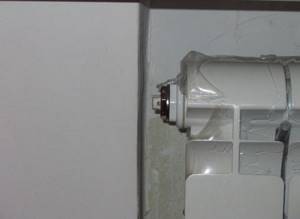
Modern heating devices are equipped with special valves
Older type heating appliances do not have such taps. In this case, you will have to work a little and remove the plug. Before you start unscrewing, be sure to place the basin on the floor. Under no circumstances should the lid be completely unscrewed; it should only be unscrewed slightly until a barely audible hiss appears. At this point, you need to put the key aside and wait until all the excess air comes out of the system and water begins to ooze out. After this, the plug must be carefully tightened. Just in case, you can leave the basin for a while to make sure that water does not drip.
It is not allowed to completely unscrew the plug! This may cause the apartment to flood!
Experts explain why the batteries are cold and the riser is hot
You can't warm your hands on cold radiators.
There can be many reasons why the coolant supply pipe is hot and the radiator is cold. For general development, specialists name only the main ones:
- the central valve on the heat supply line is closed or the return line is closed;
- insufficient coolant flow;
- airing of the system or a specific riser, radiator;
- the heating system is not balanced;
- contamination in the heating circuit;
- reducing the cross-section of the coolant supply pipe.
If the riser in the apartment is warm and the radiator is cold, you need to contact the organization responsible for the heat supply of the house. Its specialists are obliged to fix any malfunction free of charge and within 24 hours.
However, the following actions by the residents of the house will help the technicians who come to the call to quickly eliminate the malfunction of the heating circuit:
- Is it necessary to install a hot pipe and a cold radiator in only one apartment or does this problem affect the entire riser. Perhaps the heating wiring of the entire entrance is faulty;
- it doesn’t hurt to go around all the entrances and see if the heating elements are hot there;
- you can go down to the basement and inspect the pipes for breakdowns. Even a drip leak leads to a drop in pressure in the system. This adversely affects her work.
All information received should be passed on to specialists. However, there are situations when the organization involved in heating the house refuses to repair the wiring. In this case, residents must contact regulatory authorities with a complaint about poor quality services. Also read: “Where should I go if the batteries don’t heat up?”
Which antifreeze should you choose for your home heating system so as not to be poisoned later if it is mixed into the hot water circuit?
Everything you need to know about filling your heating system with antifreeze can be found here.
Device for cleaning the circuit.
If the batteries do not heat up the riser. If the riser is cold, the battery is cold - this is a sure sign that the main line through which the coolant flows is blocked. To confirm this, you need to walk through the neighboring apartments. They should warm up well. In this case, only a plumber, who will have drawings of the heating wiring of the house, can fix the breakdown.
The heated towel rail is cold, the heated towel rail in the bathroom does not work
It’s very nice when you come to a cozy bathroom, take a shower and take a warm towel from the heated towel rail. But sometimes problems arise with this device that can ruin any impression of going to the shower. Professionals will help answer the question why the heated towel rail became cold.
What is good about a heated towel rail
This heating device is designed for installation in bathrooms and is responsible for drying and heating large and small towels. Therefore, when the heated towel rail does not heat, the comfort of the bathroom is out of the question.
In addition to towels, this device is convenient for drying and heating small items and linen to a comfortable temperature. It can also be used as a compensating loop, and this will not be the reason why the heated towel rail does not heat.
With the onset of cold winter, another useful function appears - additional heating. Therefore, if in frosty weather the heated towel rail is cold, although there is hot water, staying in the bathroom may seem less comfortable.
A wide range of heated towel rails is divided into the following categories:
- water;
- electric.
The first category is made in the form of a curved pipe with constantly circulating water. And electrical appliances are suitable not only for the bathroom, but for any room. The only condition is the presence of an outlet.
When making a purchase, no one will give you a guarantee, and a situation where the heated towel rail in the bathroom does not heat can happen at any time. But unlike manufacturers, you can get guaranteed quality work from the specialists of the Plumber Service. Highly qualified workers will not only answer the question of why the heated towel rail is cold, but will also easily solve it.
What to do if the radiators in the apartment are cold and the riser is hot?
Regardless of whether the cold heating equipment is only in the riser or in the entire entrance, and possibly throughout the house, you must seek help from qualified specialists. In the case of an apartment building, this is a plumber of the company that is responsible for the heating supply of the house.
Cold batteries with a hot riser may be due to a clogged system or the formation of an air lock in it. An important factor is the pressure in the wiring. In some cases, the problem of low coolant flow is relevant. It is possible to independently find out the reason for the low efficiency of heating elements. But only a true professional in his field will clearly answer any questions that arise and competently fix the breakdown. This video will help you to make your radiators heat better:
Heating is a complex system that has its own design features. Owners often ask the question: why is the radiator hot on top and cold on the bottom? This is a serious problem, it causes a lot of inconvenience and requires careful analysis.
Why is this situation dangerous?
- The actual efficiency of the radiator decreases.
- The room temperature decreases.
- It becomes uncomfortable to be in the room.
- Adjustment and use of additional fittings cannot cope with this situation.
Installed radiator in a wooden house
But what is the reason for such a problem and is there a worthy solution? This issue should be looked into in more detail and some advice given to the owners.
Important!
Please note that a slight temperature difference between the lower and upper parts is not a deviation. You should be concerned when the heating decreases significantly; it negatively affects the efficiency of the radiator.
Why is the bottom of the heating radiator cold? It should be said that in almost all battery models the temperature in the lower part is slightly lower than at the inlet. This is due to the high level of heat transfer; the water has time to cool significantly before leaving the device. A temperature difference arises, which somewhat frightens the owners. So, if there are small differences, there is no need to worry, this is a completely normal situation.
But if the difference increases significantly, the lower part is a little warm or almost cold, then this fact indicates serious problems. The efficiency of the system is significantly reduced, the battery is unable to provide sufficient heat. This negatively affects the temperature in the room, so immediate action must be taken.
The most common reasons:
- During installation, the supply and return pipes were mixed up.
- Low fluid circulation rate.
The first case is quite common; similar situations can arise when connecting independently or using the services of unqualified craftsmen. Any violations of the circuit lead to the impossibility of further full operation of the radiator.
In the second case, the water flow rate inside the radiator is quite low, which negatively affects its operation. The liquid has time to cool completely before leaving the battery. A slowdown in the flow rate can be caused by many reasons, each of which requires prompt elimination.
How to get rid of condensation on pipes
You need to start with the simplest thing - remove sources of high humidity in a specific room where condensation constantly occurs.
Avoid active evaporation when boiling water (use tight-fitting lids). If you do only this, then there will be much fewer reasons for condensation to occur. For example, you should not hang wet (washed) laundry next to a ventilation or water pipe.
In the event that the usual precautions do not give positive results, it is necessary to take a closer look at ventilation. In apartment buildings, it is provided for by the house construction project - ventilation shafts and pipes are laid
If there is not enough draft (no air movement) in the ventilation pipe (duct), it means that the communication is blocked (clogged) with some object, or simply accumulated dust and it needs to be cleaned.
For complete confidence in the performance of the ventilation system, you should install fans specifically designed to forcefully influence the movement of air flows.
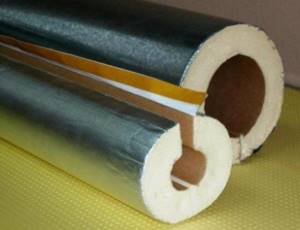
For private houses, if there is no ventilation system for rooms with unexpected high humidity. you'll have to install it.
Without such an addition, the humidity will remain at the same level.
Regarding stove and ventilation pipes. on which condensed moisture can also form, it is necessary to bring them into working condition corresponding to the correct performance of their operating functions.
So for a chimney (chimney), the temperature of the smoke passing through it is very important. If it is not high enough, moisture will form and accumulate, which will lead to the need to repair or replace the entire smoke exhaust system.
That is, to prevent condensation from occurring, you need to make the stove so that the temperature of the smoke coming out of it is quite high (230 degrees or more).
For ventilation systems, the opposite is true. Sufficiently cooled air should enter there. For this purpose, kitchen hoods are installed directly above the stove.
They not only capture the odors of cooking food (many believe that this is their purpose), but also, due to their large surface, they effectively absorb the heat that a stove or oven provides.
What to do if condensation appears on cold water pipes?
There are cases when everything is in order with ventilation, but in a room, for example, in a bathroom, a large temperature difference periodically occurs between the pipes and their environment.
This happens when there are people in the house who like to take very hot showers. In this case, a large amount of steam is formed, which, in contact with the pipes, falls on them in the form of condensate.
This phenomenon can be overcome in only one way - by using thermal insulation materials. with which it is necessary to close the pipes from contact with the environment.
There are several options on sale:
- mineral wool mats with an external coating of aluminum foil;
- tubes made of porous materials (rubber, polystyrene, foam).
In the first case, the problematic pipe is wrapped with this material and then fixed. In the second, the tubes are cut lengthwise and placed on the weeping pipe.
Their internal diameter is easy to select for the desired cross-section, since this is provided by the manufacturers and almost all standard sizes are commercially available.
Old methods of dealing with condensation, such as moisture-absorbing bags (silica gel), which are sent to dry when wet, or gauze with the free end lowered into a jar to collect water, are vitally outdated. They can only be used to temporarily solve the problem.
Incorrect connection
Incorrect pipe connection is one of the possible reasons for reduced radiator efficiency. This is a gross mistake; experienced craftsmen do not make such mistakes; most often they arise after the work is performed by amateurs.
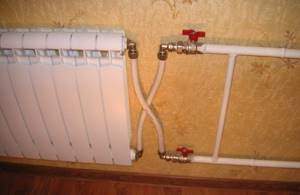
Incorrect radiator installation
The return pipe is connected to the upper pipe, the supply pipe is connected to the lower pipe. As a result, a range of related problems arise:
- The circulation of water and the full operation of the heating system are completely disrupted.
- The efficiency of the radiator and its heat transfer decrease; water is unable to completely fill all sections.
- The process of draining liquid from the battery is disrupted.
Clogged heating system
Rust, salt deposits and other contaminants can significantly reduce the diameter of the holes for the passage of coolant or completely close them. The problem causes the home owner to bleed the air, but the battery is still cold. The solution is cleaning with water under pressure or a special solution.
Deposits in the pipe
If shut-off valves are installed in front of the radiator, then the procedure can be completed even during the heating season . First, the coolant supply is shut off, then the connecting elements are unscrewed. In a private house, it is more convenient to take the battery outside and clean it there. In an apartment, they are usually placed in the bathroom, having previously protected the enamel of the bathtub from scratches and chips.
Pneumatic radiator flushing device
Water is supplied to the battery from a pneumatic device, and for best effect it must be hot. To remove rust and deposits, tap the radiator. In particularly advanced cases, a special mixture is poured in, which acts on the deposits for several hours, then is washed off. With open access to the entire heating system, cleaning can be done without removing the radiators. The equipment is connected to the return hole, and a hose is installed at the other end of the system to remove contaminants. The procedure continues until clean water begins to flow freely from the pipes. Reviews from some homeowners indicate that flushing does not always have a positive effect for a long time . Sometimes it’s easier to replace old radiators with new ones than to clean the entire system every 1-2 years. This is especially true for cast iron batteries, which are more susceptible to corrosion inside than others.
Other reasons
A common reason is a reduced coolant flow rate. This problem can occur in several cases:
- Narrowed pipe section.
- The coolant moves at low speed directly in the heating system.
Low coolant movement speed occurs when the pump power is insufficient to circulate the liquid within the system. Water cannot overcome the radiator with sufficient speed and go into the outlet. A similar problem often arises in gravity systems; they completely lack additional equipment.

The simplest gravitational scheme
Narrowing of pipes occurs in several cases:
- Incorrect soldering of polypropylene pipes.
- Problems arise when installing an adjustment valve with a narrowed cross-section.
- Presence of deposits in the pipe, reducing throughput.

Another possible reason is a fairly low room temperature. The coolant in the radiator cools faster and delivers the maximum amount of energy. It is quite natural that the bottom of the battery can be much colder.
Important!
It is necessary to conduct a consistent check of the system, evaluate the condition of all elements and find the cause of the problem. In the future, it will be necessary to eliminate it to ensure complete water circulation in the radiator.
Causes of problems with return flow in the batteries of a private or apartment building
There are several reasons why the return flow is not warm enough or even cold. Common problems are:
- insufficient water pressure in the system;
- small section of the pipe through which the coolant passes;
- incorrect installation;
- airiness or contamination of the system.
If a problem with cold return occurs in an apartment, then the first thing you should pay attention to is the pressure. This is especially true for rooms on the upper floors
The fact is that the principle of operation of the return flow is to quickly and continuously circulate liquid through the system. And if its speed drops, then the coolant will not have time to push out cold water and the batteries will not heat up.

Another reason for malfunction of the return flow is contamination of the heating circuit. As a rule, major cleaning of systems in multi-storey buildings is not carried out often. The sediment that accumulates on the pipe walls over time prevents the passage of liquid.
The main reason for interruptions in the operation of the heating system in a private home is incorrect installation. Most often this happens when installation is carried out without the participation of specialists. Being incompetent in this matter, it is quite easy to confuse the supply and return pipes or choose pipes of the wrong size.
Both in an apartment and in a private house, the problem of a heating system malfunction may be associated with insufficient water flow or airiness. In a similar way, the operation of the return line is affected by contamination of the pipes.
Troubleshooting methods. Why is cleaning necessary?
To understand exactly how to solve a problem, you first need to establish its source. If the batteries become cold due to insufficient water circulation, installing a special pump will help. It will regularly push water into the circuit under a certain pressure, thereby preventing the system from stopping or slowing down.
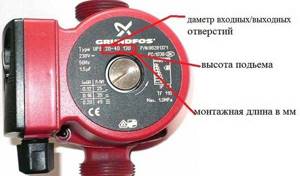
Photo 2. Marking of the Grundfos circulation pump allows you to choose the most suitable one and install it correctly.
If the reason is that the pipes are clogged, then they simply need to be cleaned. You can do this in several ways:
- using a water-pulsating mixture;
- using biological products;
- by means of pneumatic hydraulic shock.
Important! This type of cleaning is carried out regularly to prevent new problems from arising. In the event of a malfunction resulting from improper installation of the equipment, contact a specialist
A qualified specialist will certainly understand the problem and eliminate all problems. In addition, he will give practical advice and recommendations on the care and operation of the system.
In the event of a malfunction resulting from improper installation of the equipment, contact a specialist. A qualified specialist will certainly understand the problem and eliminate all problems. In addition, he will give practical advice and recommendations on the care and operation of the system.
Elimination
If you notice that the bottom is significantly colder than the top, then urgent action is required. It is necessary to follow the following algorithm to find the cause:
- Checking the correct connection.
- Inspect the radiator, bleed and clean it.
- Assess the condition of the control valves.
- Check the pipes.
- Determine the type of heating system, install or replace the circulation pump.
The first step is to check the correct connection. To do this, it is necessary to estimate the temperature of the lower pipe. If the return and supply were connected incorrectly, it will be hot. You will need to reconnect and build the circuit correctly. When connected correctly, this element remains slightly warm.
Often the cause is an air lock in the battery, which does not allow the coolant to spread throughout the radiator. The design must include a Mayevsky valve or bleeder for air removal. It is necessary to shut off the supply, open the drain and remove all air and batteries. After the tap is turned off, the heating valves are turned. In some cases, this procedure turns out to be effective.
If an adjustment valve is installed in the system, then there is a high probability that the problem is there. It is necessary to dismantle this element and carry out an inspection. If the section is narrowed, you will need to expand it using specialized tools. But it is better to purchase a higher quality part and reinstall the tap into the system.
I will describe my problem in detail, since the mechanics of the local management company shrug their shoulders, and I myself cannot understand what the reason is ((And it all started like this: We have 2 risers in our apartment - one in the hall, the other in the kitchen, which is connected through crosspieces in the kitchen and children's room. Last year everything was changed to propylene from the basement, we have a second floor, there is a bank below us, there are 2 more floors above us, the neighbor in the 5th compartment has his own apartment and is heated independently. Riser systems are based on the "supply-return" system , last year they worked well, and this year, as soon as the heating was turned on, everything was fine. It worked for a month without interruptions, the return and supply were hot. 2 weeks ago the return cooled down, and then the pipes completely cooled down. They gave a request, a mechanic came, He said that we need to wait for the cold weather, that maybe the boiler room is not adding pressure or whatever. I go upstairs to my neighbor - there is circulation above me, both risers are hot, return and supply. I go up to my neighbor on the 4th floor - everything is there, both risers heat perfectly. I am perplexed - why am I having a problem on the second floor? I think maybe something is clogged? But the pipes are new, sawn everywhere - what could be there? I don't understand. A mechanic comes, lowers something in the basement, and the risers begin to heat up. They heat up normally, cool down after 15 minutes. There is no airing, I constantly bleed through Mayevsky - only water comes out, no air. Yesterday I shut off the American 3/4ths in front of the battery, removed it, washed it (Sandital radiators, aluminum with anti-corrosion coating), put it in place (first I drained the water from the riser - both from the return and from the hot one in case there was something there got into trouble), filled it with water - the supply and the upper part of the battery began to heat up. I turn off the supply, release the return through the battery - it starts to heat up, I stop draining - it cools down. Thus, the upper half of the battery worked until 23:00, then it began to cool down. This morning the mechanic came again, threw up his hands and went up to the neighbor: everything was fine with him. As a matter of form, he went down to the basement and pumped something there - it began to circulate, then died out again. In general, help me solve the puzzle! I can't figure out what's wrong:
- Everything worked for 1.5 months, there was circulation. Return and feed worked.
- Two weeks ago everything disappeared, but only here, on the second floor. The neighbors above have everything.
- There is no blockage or clogging in the radiators, and no in the risers either.
- There is no circulation. What the heck? We didn’t change anything structurally, the circuit worked the same way last year, everything was warm!
- The housing department said that some residents also have this problem, which means I’m not alone. But they may just be airy.
- There is no airiness, everything is lowered 100 times through Mayevsky and removing the batteries.
Why is the last heating radiator bad or not heating?
Profile pipes are common in industrial and private construction.
They are used to construct outbuildings, garages, greenhouses, and gazebos. The designs can be either classically rectangular or ornate. Therefore, it is important to correctly calculate the pipe for bending. This will preserve the shape and ensure the structure’s strength and durability, on the website https://avtoindustriya.com/gruzovye-avtomobili/gruzovye-avtomobili-kitay/faw/. How to choose a jigsaw for your home. The most necessary things. Metal has its own point of resistance, both maximum and minimum.
Maximum load on the structure leads to deformations, unnecessary bends and even breaks. When making calculations, we pay attention to the type of pipe, cross-section, dimensions, density, and general characteristics. Thanks to this data, it is known how the material will behave under the influence of environmental factors. Cold batteries, possible reasons why the radiator does not heat
We take into account that when pressure is applied to the transverse part of the pipe, stress arises even at points distant from the neutral axis. The zone of most shear stress will be the one located near the neutral axis. The heating radiator does not warm up completely!
During bending, the inner layers in the bent corners are compressed and reduced in size, and the outer layers are stretched and lengthened, but the middle layers retain their original dimensions after the end of the process.
The gun that fits you goes where you look. This way, when you bring the butt of a shotgun to your face, you can pull the trigger without hesitation, confident that whatever you are looking at will receive a load of pellets right in the center. In addition, the gun that suits you is easier to handle and much more enjoyable to shoot, visit https://avtoindustriya.com/gruzovye-avtomobili/gruzovye-avtomobili-kitay/faw/.
How do you know if your gun is right for you? Most people pick up a gun, shoulder it, and lean into the sights. If the aiming line matches the expected one: “It fits well.” The downside to fitting is using a test gun with a fully adjustable stock. You shoot at a steel plate or at skeet, and at this time the master adjusts the dimensions of the stock to suit you.
Although full adjustment is a very useful thing - you can adjust the gun to suit yourself. An increasing number of shotgun models—Browning, Benelli, and Beretta semi-automatics, as well as Mossberg pump-action shotguns and semi-automatics—are sold with shims and spacers that allow you to change the bevel, drop, and length of the stock. With other guns you'll have to improvise.
Gunsmiths use 91cm or 121cm square steel plates coated with paint or lubricant to show the shot grain when checking the fit of a gun. If you don't have a plate, you can use a sheet or plastic tablecloth. Hang it with a 5 cm reticle in the center. Use a choke with a strong constriction and stand at a distance of 14 meters. Use the gun unlocked first and gently lift it toward your cheek. Focus on the target and fire as soon as the gun touches your shoulder. Don't try to aim and don't look at the front sight. Repeat until a hole appears in the target. If the hole is located strictly above or below the mark, you need to change the bend (bend) of the butt. If it is strictly to the left or to the right, you need to change the tap. Each cm of displacement at a distance of 14 meters corresponds to 1.58 millimeters of change in the size of the butt.
Very often on thematic forums the question of why the last battery is cold is discussed. This applies to both the heating circuit of a private house and the distribution of centralized heat supply in multi-apartment buildings. A situation may also arise when the heating element does not heat while being in the middle of the wiring. It is impossible to answer such questions unambiguously. After all, there can be many reasons for such a situation. Also read: “Why is half of the radiator cold?”
Experts explain why the batteries are cold and the riser is hot
You can't warm your hands on cold radiators.
There can be many reasons why the coolant supply pipe is hot and the radiator is cold. For general development, specialists name only the main ones:
- the central valve on the heat supply line is closed or the return line is closed;
- insufficient coolant flow;
- airing of the system or a specific riser, radiator;
- the heating system is not balanced;
- contamination in the heating circuit;
- reducing the cross-section of the coolant supply pipe.
If the riser in the apartment is warm and the radiator is cold, you need to contact the organization responsible for the heat supply of the house. Its specialists are obliged to fix any malfunction free of charge and within 24 hours.
However, the following actions by the residents of the house will help the technicians who come to the call to quickly eliminate the malfunction of the heating circuit:
- Is it necessary to install a hot pipe and a cold radiator in only one apartment or does this problem affect the entire riser. Perhaps the heating wiring of the entire entrance is faulty;
- it doesn’t hurt to go around all the entrances and see if the heating elements are hot there;
- you can go down to the basement and inspect the pipes for breakdowns. Even a dripping leak leads to a fall. This adversely affects her work.
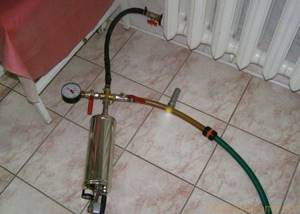
Device for cleaning the circuit.
If the batteries do not heat up the riser
. If the riser is cold, the battery is cold - this is a sure sign that the main line through which the coolant flows is blocked. To confirm this, you need to walk through the neighboring apartments. They should warm up well. In this case, only a plumber, who will have drawings of the heating wiring of the house, can fix the breakdown.
The following state of affairs, when the pipe is hot and the battery is cold, indicates a blockage in the system or the presence of an air lock. It prevents the penetration of coolant into the heating element. As a result, the latter does not warm up. Blockages can only be eliminated if you completely disassemble the radiator and force air through it under pressure. This can only be done by a specialist who has the necessary tools and equipment.
If the radiators in the entire entrance do not heat
. When the heating radiator is cold and the riser is hot, you need to pay attention to the pressure in the circuit. If the pressure is insufficient, the coolant cannot pass through all the radiators in the circuit. As a result, the batteries lower their temperature as they move away from the heat-carrying main. Residents of the house cannot increase the pressure in the system on their own, and therefore it is recommended to seek help from professionals. More specifically, call the organization that is responsible for the heat supply of the building.
The supply and return may be reversed.
Residents of a new house, when starting up the heating system for the first time, may observe the following situation: the battery is cold and the return is hot. Here it is appropriate to assume that errors were made when installing the heating elements. In this case, the pipes supplying coolant and the return circuit are swapped. If we are talking about an individual heating circuit, then it is worth taking a closer look at the circulation pump. It may not be installed correctly.
When asked why there is cold return in the radiators, experts clearly point to an incorrectly designed heating system. In some cases, it is appropriate to talk about low coolant flow.
A drastic measure is to replace the heating batteries ↑
Unfortunately, old radiators that have been heating your home for decades can no longer be brought back to life by flushing. If, even after general internal cleaning, the batteries remain cold when the riser heats up, they will have to be mercilessly replaced with new ones. Radiators made of stainless steel or chrome-plated are ideal for the bathroom. When purchasing a painted radiator, you should take into account the quality of paint application - in conditions of high humidity it must be impeccable.
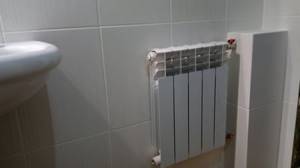
A new radiator will solve the problem of insufficient heating
Aluminum heat exchangers have low operating pressure, so they are not recommended for installation in apartments located above the 8th floor. In addition to this drawback, they have another significant drawback - the inner surface of these products is susceptible to corrosion, so you should not expect long years of service from them.
Radiators with towel hangers are produced especially for bathrooms. They not only perform their main function, but also allow you to neatly hang towels for quick drying. To decorate your bathroom, you can choose unusual radiators, which are now easy to find.
Replacing radiators is a complex and time-consuming process that is best left to professionals. Naturally, major repairs should be planned for the season when the heating in the house is turned off.
It is recommended to install chrome surfaces away from possible splashes, otherwise they will constantly become covered with unsightly stains.
What to do if the radiators in the apartment are cold and the riser is hot?
Regardless of whether the cold heating equipment is only in the riser or in the entire entrance, and possibly throughout the house, you must seek help from qualified specialists. In the case of an apartment building, this is a plumber of the company that is responsible for the heating supply of the house.
Cold batteries with a hot riser may be due to a clogged system or the formation of an air lock in it. An important factor is the pressure in the wiring. In some cases, the problem of low coolant flow is relevant. It is possible to independently find out the reason for the low efficiency of heating elements. But only a true professional in his field will clearly answer any questions that arise and competently fix the breakdown. This video will help you to make your radiators heat better:
Methods for flushing radiators and new methods for cleaning the internal surface ↑
During operation, the internal surface of the heating system becomes covered with rust, salt deposits, and other impurities. All this complicates the circulation of hot water and significantly reduces the air temperature in the apartment. Regular cleaning of heating radiators removes blockages and restores normal circulation of coolant.
It is possible to clean the heat exchanger, equipped with outlet and inlet taps, even during the period when the central heating is already working, but when the riser is hot, the batteries remain cold. First of all, turn off both taps, then remove the radiator using a suitable wrench and divide it into sections. The next part of the work does not require special skills - each element is washed well under a strong stream of water. If a lot of scale has accumulated inside and the sediment cannot be easily removed, you will have to deal with it using chemicals. After drying, the entire structure is assembled to its original form, and all joints are carefully sealed.
Heavy batteries that cannot be removed are washed on site. To do this, remove one plug, and then pour inside, preferably under pressure, hot water to which a chemical solvent has been added, for example, soda ash. The heating element is left in this state for a couple of hours, then the solution is drained and clean water is poured under pressure. It is advisable to do several rinses, and if necessary, you can repeat the chemical treatment. To enhance the effect, you can lightly tap the compartments before pouring water, this will help the plaque move away from the walls.
Ideally, flushing should be done before the start of the heating season, when utility services have not yet poured water into the system, but have already managed to blow out the risers.
For heat exchangers that are difficult to turn off and wash, there is professional equipment that allows you to precisely remove deposits in any season, including the heating season. The result is achieved through high pressure, compressed air and shock waves. Such equipment allows you to clean not only radiators, but also pipes.

